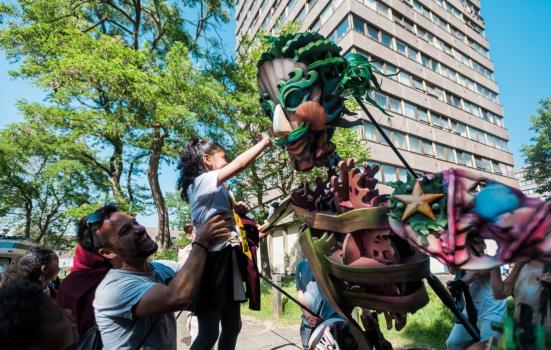Voters across England go to the polls next week (2 May) to elect many thousands of new councillors and 10 metro mayors – one of them being the Mayor of London. Phoebe Gardiner outlines what mayoral hopefuls need to understand about the capital’s culture.

James Tye
In March this year, London was voted as the best city for culture in the world. Quieting the cynic in me that questions the validity of a travel agency-led report, the commentary around it from leading media titles is reflective of how London sees itself and its culture. We’re damn proud of our arts and culture offering - and so we should be.
Say what you like about the traffic, the tube, rental prices and obviously the weather, not many could deny London has a banging cultural scene. Whatever your flavour – you can go from Rembrandt to an all-day rave, street art and skateboarding to Saatchi and Sadler's Wells.
Our historic and world-famous art institutions remain free to everyone, and there are more new artists and genres seeping out of the city's pores all the time (digi-punk trip-hop, anyone?).
Mayor Sadiq Khan knows this. It’s why he’s leant into the power of the creative industries in his recent campaign activity. But considering his influence, it’s important to note the environment he has been operating in. London's culture scene sits within the wider UK creative industries. And, as this audience well knows, their contribution is far higher than the value most people give them.
Tory record in office
In 2019, pre-pandemic, they contributed £115.9bn in gross value added to the country’s economy: greater than aerospace, automotive, life sciences and oil and gas sectors combined. During the worst of Covid, while their economic output fell, they were less adversely affected than the UK economy as a whole, and have been recovering almost four times faster.
PM Rishi Sunak loves to talk about this as a “true British success story”. Between the 13 Conservative Culture Secretaries since 2010, his party has achieved some good like the recently announced tax breaks for arts in England. But they’ve also cut creative subjects in the state school curriculum, and made some serious blunders like the widely-lambasted Fatima poster.
And then there’s Arts Council England (ACE). Over the past decade, ACE's funding pot for London has been drastically reduced - in line with central government’s edict to level up the regions. The last national funding round cut London’s money in favour of the regions, leading to closures of organisations like South East Dance in Greenwich, and relocations of organisations such as ENO to Manchester.
Swimming against the tide
Sadiq Khan has done well to swim against this tide. He and his office have put some impactful initiatives in place. First, he appointed Justine Simons as Deputy Mayor for Culture, a role in which she has been visible and vocal, and created the role of Night Czar. Although its incumbent Amy Lamé has received criticism, it’s nonetheless a recognition of the importance of London's nighttime activity and how it sits hand-in-glove with the entertainment economy.
Khan also instigated the London Borough of Culture, which not only spotlights talent from all over London but has the benefit of helping local authorities establish the infrastructure to support art and culture provision. He launched Creative Enterprise Zones in 2018 to provide permanent affordable workspaces, sector skills and employment for creative businesses.
He's put £600m into East Bank at Queen Elizabeth Olympic Park – promising culture, education, innovation and growth. And he's spearheaded campaigns such as his latest London Creates – working with cultural leaders to celebrate London as the world’s most creative capital.
London's cultural independence
Much of Kahn's success has come from establishing cultural independence for London. He recognised the importance of London's cultural reputation to its brand (and his), attracting talent, business, investment and tourism.
He also saw that to support the creative economy you can't just pipe money to arts and artists - you have to strengthen the built environment around it. In this, he continued a notable legacy of Boris Johnson – the 2015 guidance to help developers integrate culture into their plans.
It inconceivable the next mayor won’t continue to be a champion of the creative and cultural sector, given how many jobs rely on it, and how central it is to London’s global brand. And maintaining the cultural independence of London will be vital to continue the success story.
There may be a further reduction in Arts Council England funding – if there is an Arts Council at all - and there will continue to be steep competition from global cities in the emergent createch and screen arts.
As London and its cultural hotspots grow, developers have a responsibility for cultural place-maintaining rather than making: supporting existing communities while building in them, opening the door for artists and creatives of all kinds to help lay down layers of authenticity that makes London what it is.
Mayoral hopefuls take heed.
Phoebe Gardiner leads on cultural placemaking at London Communications Agency.
![]() londoncommunications.co.uk
londoncommunications.co.uk
![]() @LDNcomms
@LDNcomms
 linkedin.com/in/phoebegardiner/
linkedin.com/in/phoebegardiner/




